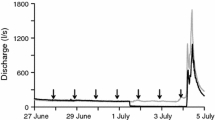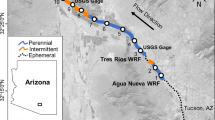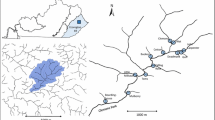Abstract
Surface water abstraction from rivers for irrigated agriculture is one of the largest uses of freshwater resources in the world. Water abstraction has important impacts on the structure of riverine assemblages. However, little work has examined the chronic, season-long impacts on ecosystem functions. Invertebrate drift is an important ecosystem function of river systems influencing nutrient cycling, food webs, and invertebrate population dynamics. We examined the season-long impact of reduced discharge resulting from multiple points of abstraction on drift assemblage composition, concentration, and total drift load. Early in the season, water abstraction had little impact on drift assemblage composition. However, later in the irrigation season, the drift assemblage at sites impacted by water abstraction diverged from upstream, control sites. The degree of change in assemblage composition at impacted sites was related to the amount of water abstracted such that sites with the lowest discharge also had assemblages that differed most strongly from control sites. Drift assemblages at impacted sites became dominated by tolerant microcrustaceans. In addition, water abstraction resulted in an increase in drift concentration (ind./m3). However, despite this increase in concentration at impacted sites, total drift load (# of invertebrates drifting in the river) decreased with decreasing discharge.









Similar content being viewed by others
References
Anholt, B. R., 1995. Density dependence resolves the stream drift paradox. Ecology 76: 2235–2239.
Anderson, D. H., S. Darring & A. C. Benke, 1998. Growth of crustacean meiofauna in a forested floodplain swamp: implications for biomass turnover. Journal of the North American Benthological Society 17: 21–36.
Baker, D. W., B. P. Bledsoe, C. M. Albano & N. L. Poff, 2010. Downstream effects of diversion dams on sediment and hydraulic conditions of Rocky Mountain streams. River Research and Applications 27: 388–401.
Benejam, L., P. L. Angermeier, A. Munné & E. García-Berthou, 2010. Assessing effects of water abstraction on fish assemblages in Mediterranean streams. Freshwater Biology 55: 628–642.
Brewin, P. A. & S. J. Ormerod, 1994. Macroinvertebrate drift in streams of the Nepalese Himalaya. Freshwater Biology 32: 573–583.
Brittain, J. E. & T. J. Eikeland, 1988. Invertebrate drift – a review. Hydrobiologia 166: 77–93.
Burnham, K. P. & D. R. Anderson, 2002. Model Selection and Multimodel Inference: A Practical Information-Theoretic Approach, 2nd ed. Springer-Verlag, New York.
Caton, L. W., 1991. Improving subsampling methods for the EPA “rapid bioassesment” benthic protocols. Bulletin of the North American Benthological Society 8: 317–319.
Clarke, K. R., 1993. Non-parametric multivariate analyses of changes in community structure. Austral Journal of Ecology 18: 117–143.
Corrarino, C. A. & M. A. Brusven, 1983. The effects of reduced stream discharge on insect drift and stranding of near shore insects. Freshwater Invertebrate Biology 2: 88–98.
Cuffney, T. F., M. R. Meador, S. D. Porter & M. E. Gurtz, 1997. Distribution of fish, benthic invertebrate, and algal communities in relation to physical and chemical conditions, Yakima River Basin, Washington, 1990. Water Resources Investigations Report 96-4280, U.S. Geological Survey, Raleigh, North Carolina, USA.
Death, R. G., Z. S. Dewson & A. B. W. James, 2009. Is structure or function a better measure of the effects of water abstraction on ecosystem integrity? Freshwater Biology 54: 2037–2050.
Dewson, Z. S., A. B. W. James & R. G. Death, 2007. A review of the consequences of decreased flow for instream habitat and macroinvertebrates. Journal of the North American Benthological Society 26: 401–415.
Dymond, J. R., 1984. Water temperature change caused by abstraction. Journal of Hydraulic Engineering 110: 987–991.
Gore, J. A., 1977. Reservoir manipulations and benthic macroinvertebrates in a prairie river. Hydrobiologia 55: 113–123.
Gore, J. A., 2006. Discharge Measurements and Streamflow Analysis. In Hauer, F. R. & G. A. Lamberti (eds), Methods in Stream Ecology, 2nd ed. Academic Press, San Francisco: 51–77.
Grossman, G. D., 2014. Not all drift feeders are trout: a short review of fitness-based habitat selection models for fishes. Environmental Biology of Fish 97: 465–473.
Harvey, B. C., R. J. Nakamoto & J. L. White, 2006. Reduced streamflow lowers dry-season growth of rainbow trout in a small stream. Transactions of the American Fisheries Society 135: 998–1005.
Hay, C. H., T. G. Franti, D. B. Marx, E. J. Peters & L. W. Hesse, 2008. Macroinvertebrate drift density in relation to abiotic factors in the Missouri River. Hydrobiologia 598: 175–189.
Hayes, J. W., N. F. Hughes & L. H. Kelly, 2007. Process-based modelling of invertebrate drift transport, net energy intake and reach carrying capacity for drift-feeding fishes. Ecological Modelling 207: 171–188.
Herren, J. R. & S. S. Kawasaki, 2001. Inventory of water diversions in four geographic areas in California’s central valley. Fish Bulletin 179: 343–355.
James, A. B. W., Z. S. Dewson & R. G. Death, 2009. The influence of flow reduction on macroinvertebrate drift density and distance in three New Zealand streams. Journal of the North American Benthological Society 28: 220–232.
Kennedy, T. A., C. B. Yackulic, W. F. Cross, P. E. Grams, M. D. Yard & A. J. Copp, 2014. The relation between invertebrate drift and two primary controls, discharge and benthic densities, in a large regulated river. Freshwater Biology 59: 557–572.
Kenny, J. F., N. L. Barber, S. S. Huston, K. S. Linsey, J. K. Lovelace & M. A. Maupin, 2009. Estimated use of water in the United States in 2005. U.S. Geological Survey Circular 1344.
Lange, K., C. R. Townsend, R. Gabrielsson, P. C. M. Chanut & C. D. Matthaei, 2014. Responses of stream fish populations to farming intensity and water abstraction in an agricultural catchment. Freshwater Biology 59: 286–299.
Leung, E. S., J. S. Rosenfeld & J. R. Bernhardt, 2009. Habitat effects on invertebrate drift in a small trout stream: implications for prey availability to drift-feeding fish. Hydrobiologia 623: 113–125.
Matthaei, C. D., J. J. Piggott & C. R. Townsend, 2010. Multiple stressors in agricultural streams: interactions among sediment addition, nutrient enrichment and water abstraction. Journal of Applied Ecology 47: 639–649.
McCune, B. & J. B. Grace, 2002. Analysis of Ecological Communities. MjM Software, Gleneden Beach.
McCune, B. & M. J. Mefford, 2005. PC-Ord, Multivariate Analysis of Ecological Data, v. 5.0. MjM Software, Gleneden Beach.
Meier, W., C. Bonjour, A. Wüest & P. Reichert, 2003. Modeling the effect of water diversion on the temperature of mountain streams. Journal of Environmental Engineering 129: 755–764.
Merritt, R. W., K. W. Cummins & M. B. Berg, 2008. An Introduction to the Aquatic Insects of North America, 4th ed. Kendall/Hunt Publishing Company, Dubuque.
Miller, S. W., D. Wooster & J. Li, 2007. Resistance and resilience of macroinvertebrates to irrigation water withdrawals. Freshwater Biology 52: 2494–2510.
Minshall, G. W. & P. V. Winger, 1968. The effect of reduction in stream flow on invertebrate drift. Ecology 49: 580–582.
Musselwhite, J. & M. S. Wipfli. 2004. Effects of alternatives to clearcutting on invertebrate and organic detritus transport from headwaters in southeastern Alaska. General Technical Report PNW-GTR-602. U.S. Department of Agriculture, Forest Service, Pacific Northwest Research Station, Portland, OR, USA.
Pinheiro, J., D. Bates, S. DebRoy, D. Sarkar & R Core Team. 2015. nlme: Linear and Nonlinear Mixed Effects Models. R package version 3. 1–122.
Poff, N. L. & J. V. Ward, 1991. Drift responses of benthic invertebrates to experimental streamflow variation in a hydrologically stable stream. Canadian Journal of Fisheries and Aquatic Sciences 48: 1926–1936.
Poff, N. L. & D. D. Hart, 2002. How dams vary and why it matters for the emerging science of dam removal. BioScience 52: 659–668.
R Core Team, 2012. R: A Language and Environment for Statistical Computing. R Foundation for Statistical Computing, Vienna.
Rader, R. B. & T. A. Belish, 1999. Influence of mild to severe flow alterations on invertebrates in three mountain streams. Regulated Rivers: Research and Management 15: 353–363.
Richardson, W. B., 1991. Seasonal dynamics, benthic habitat use, and drift of zooplankton in a small stream in southern Oklahoma, USA. Canadian Journal of Zoology 69: 748–756.
Shearer, K. A., J. D. Stark, J. W. Hayes & R. G. Young, 2003. Relationships between drifting and benthic invertebrates in three New Zealand rivers: implications for drift feeding fish. New Zealand Journal of Marine and Freshwater Research 37: 809–820.
Shiozawa, D. K., 1986. The seasonal community structure and drift of microcrustaceans in Valley Creek, Minnesota. Canadian Journal of Zoology 64: 1655–1664.
Thorp, J. H. & A. P. Covich (eds), 2010. Ecology and Classification of North American Freshwater Invertebrates, 3rd ed. Academic Press, London, UK.
Tonkin, J. D. & R. G. Death, 2013. Macroinvertebrate drift-benthos trends in a regulated river. Fundamental and Applied Limnology 182(3): 231–245.
Urabe, H., M. Nakajima, M. Torao & T. Aoyama, 2010. Evaluation of habitat quality for stream salmonids based on a bioenergetics model. Transactions of the American Fisheries Society 139: 1665–1676.
Vannote, R. L., G. W. Minshall, K. W. Cummins, J. R. Sedell & C. E. Cushing, 1980. The river continuum concept. Canadian Journal of Fisheries and Aquatic Sciences 37: 130–137.
Vinson, M. R. & C. P. Hawkins, 1996. Effects of sampling area and subsampling procedure on comparisons of taxa richness among streams. Journal of the North American Benthological Society 15: 392–399.
Wada, Y., L. P. H. van Beek & M. F. P. Bierkens, 2011. Modelling global water stress of the recent past: on the relative importance of trends in water demand and climate variability. Hydrology and Earth System Sciences 15: 3785–3808.
Walton Jr, O. E., S. R. Reice & R. W. Andrews, 1977. The effects of density, sediment particle size and velocity on drift of Acroneuria abnormis (Plecoptera). Oikos 28: 291–298.
Waters, T. F., 1972. The drift of stream insects. Annual Review of Entomology 17: 253–272.
Weber, N., N. Bouwes & C. E. Jordan, 2014. Estimation of salmonid habitat growth potential through measurements of invertebrate food abundance and temperature. Canadian Journal of Fisheries and Aquatic Science 71: 1158–1170.
Whittier, T. R. & J. Van Sickle, 2010. Macroinvertebrate tolerance values and an assemblage tolerance index (ATI) for western USA streams and rivers. Journal of the North American Benthological Society 29: 852–866.
Winter, B., 2013. Linear Models and Linear Mixed Effects Models in R with Linguistic Applications. arXiv:1308.5499, http://arxiv.org/pdf/1380.5499.pdf.
Wipfli, M. S. & D. P. Gregovich, 2002. Export of invertebrates and detritus from fishless headwater streams in southeastern Alaska: implications for downstream salmonid production. Freshwater Biology 47: 957–969.
Wipfli, M. S. & J. Musslewhite, 2004. Density of red alder (Alnus rubra) in headwaters influences invertebrate and detritus subsidies to downstream fish habitats in Alaska. Hydrobiologia 520: 153–163.
Zuur, A. F., E. N. Ieno, N. J. Walker, A. A. Saveliev & G. M. Smith, 2009. Mixed Effects Models and Extensions in Ecology with R. Springer Science + Business Media, New York.
Author information
Authors and Affiliations
Corresponding author
Ethics declarations
Conflict of interest
We declare no conflicts of interest with any of the editors or possible reviewers we selected.
Ethical Approval
All authors agree that the following ethical standards were met when the research was conducted, the data were analyzed, the manuscript was written, and the manuscript was submitted. None of the authors of this manuscript currently have research projects or research proposals in review with any of these people. In addition, none of the authors of this manuscript have been co-authors or are currently co-authors on manuscripts in preparation with any of these people.
Human and Animal Rights
Our research did not involve human or any vertebrate animal subjects. Our research involved only the collection of aquatic invertebrates, none of which, to the best of our knowledge, are threatened, endangered or in any way protected by United States federal or state laws. Finally, all authors have consented to having the manuscript submitted to Hydrobiologia.
Additional information
Handling editor: Marcelo S. Moretti
Rights and permissions
About this article
Cite this article
Wooster, D., Miller, S.W. & DeBano, S.J. Impact of season-long water abstraction on invertebrate drift composition and concentration. Hydrobiologia 772, 15–30 (2016). https://doi.org/10.1007/s10750-015-2611-8
Received:
Revised:
Accepted:
Published:
Issue Date:
DOI: https://doi.org/10.1007/s10750-015-2611-8




